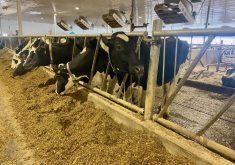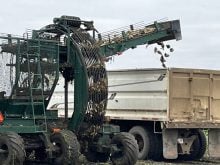CLARESHOLM, Alta. – Owning a ranch in wide open spaces was a lifelong dream for Brian and Shaunere Lane.
After years of planning and saving, the couple acquired Brown Creek Ranch from local rancher Margaret Carroll in 1997.
Located 33 kilometres west of Claresholm in the southwestern Alberta foothills, the land was once part of an older, larger property known as the 44 Ranch. In 1956 it was broken into parcels.
Brian was raised in the area and knew the place well but Shaunere came from San Antonio, Texas, with a dream she could move to the farm someday. The move from Texas to southern Alberta turned out well and she is as devoted to the place as her husband.
Read Also

Accurate accounting, inventory records are important
Maintaining detailed accounting and inventory records is not just a best practice; it’s a critical component of financial health, operational efficiency and compliance with programs like AgriStability.
“Every place has its own beauty,” she said.
When they married 16 years ago, Brian was working three jobs. He was a pen rider at the Western Feedlots High River operation for eight years. The work was hard but he learned about animal health and management. At the same time he was helping at his family’s farm and working for the previous owner of Brown Creek Ranch.
The young couple took on a major challenge in tough country where about 450 millimetres of precipitation fall each year and dry Chinook winds that sweep the hills bare. When they arrived a decade ago, the land had been overgrazed and the corrals and buildings needed work.
They slowly turned the place around using common sense and learning from neighbours who were expert grazers.
That dedication was enough for them to be named the Alberta environmental stewards for 2007.
When they recently completed an environmental farm plan, they realized they needed more improvements to bring the soil, grass and water to the level they wanted.
They put up more than six kilometres of fencing and started a rotational grazing plan to rest and restore the range on about 1,700 acres. That created new fields for them to graze.
They built up a herd of 160 purebred and commercial Angus cows and place only a single cow-calf pair on 12 to 15 acres of grass. They try to never graze the same field more than once a year.
Additional grass is found in a summer forestry permit and they recently bought shares in the nearby Waldron Ranch, which is run like a grazing co-op. They have some irrigated hayland and subscribe to the theory that it is cheaper to have the hay put up on a custom basis than to own equipment and burn fuel to make winter feed.
A swath grazing program using an oat and barley mix that starts in December supplements winter feed.
“It’s the cheapest way to winter a cow,” said Brian.
The plan is to graze year round relying on a carryover of rough fescue into the winter. This grass is prized because it holds its protein value and can sustain cows through the tough winter months.
“Our main income comes from the grass so our main priority is the grass,” said Brian.
He likes to think people are getting better at managing this resource although after the last severe drought in 2002, some grasslands may have deteriorated past the point of rehabilitation.
“The more you graze it, the weaker the grass gets,” he said.
The Lanes have seen how overgrazing encourages troublesome weed growth. Spraying is a last resort and they have hand pulled problem weeds like foxtail barley and burdock. Houndstongue and blue burr are also found but are almost under control due to grazing management.
Water is critical in this area. They restored the riparian areas and developed the natural springs on their property by fencing them off and running a gravity-fed line to the troughs. They also use solar powered pumps to bring the water to the cattle.
Their seasons are based on their cow herd’s natural cycles.
They breed cows for 45 days using artificial insemination and natural breeding. A tight breeding schedule helps produce more uniform calves at sale time. To keep the bull battery fresh, they partner with a friend and share bulls. That way they are able to spend more on better bulls and improve the yearly calf crop.
The purebreds start calving by the end of December so their yearling bulls have the advantage of added age at sale time. The commercial animals come in February.
They are working on building a reputation herd so fertility and longevity are important. They keep female replacements from the high producing cows.
Calves are sold in the fall through the TEAM electronic auction. There is less transportation stress on the cattle and if they do not accept the bid, “I have lost nothing and I can gamble the next week,” said Brian.
The calves are age verified but so far they have seen no premiums come their way for this extra effort. The real premiums come from vaccination and record keeping programs.
Their most recent marketing venture in the last two years is selling purebred bulls to commercial producers in a joint sale with AVH Simmentals and Bar 15 Stevick Angus Ranch owned by Quinton and Anne Stevick from Pincher Creek, Alta.
Potential herd sires are watched throughout the year. They may start with 20 candidates and end up with 10 bulls they believe are good enough to sell.
To save sales costs, they opted for a four hour silent auction sale held at Pincher Creek. They set a floor price and put pedigrees, performance information and pictures on-line for viewing ahead of time.
They offered seven bulls last year and plan to offer 10 this year.
The most important part of the sale is follow up with the customers to see how the bulls worked.
The purebreds were added to the ranch mix to earn extra money but the Lanes felt they needed more income. They developed a six-bed guest cabin at the same time BSE was discovered in Canada. That extra business helped subsidize the ranch operations during the height of the crisis.
Guests have come from all over the world and are treated to a taste of ranch life and home cooking. The tourists can go horseback riding, help with ranch chores or just relax. Shaunere is a member of country vacation groups with most of the bookings coming from the internet.
Guests may book six months in advance or take a chance and drive into the yard. People from around the world marvel at the scenery and the hospitality where the land remains untouched by looming subdivisions or encroaching oil and gas development.
That is the way the Lanes hope to keep it. They are just far enough away from town to savour the outdoor life while still enjoying the conveniences for their four children: Ty, 15, Chancey, 13, Chloe, 8 and Holly, 6. The children are fully involved in the operation and two have indicated a desire to continue the dream of ranch life.















